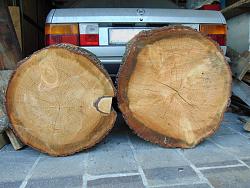To what Tool maker 51 said about sand instead of concrete. I once needed a completely stable stand for a 10 inch bench grinder I made it out of an old 18" diameter brake drum a well worn plow disc welded inside the drum just far enough so as the disc could not touch the floor the center hole filled then a length of 8" casing pipe welded to the center hole of the drum all stud holes filled then I filled the whole thing with a mixture of fine sand and used hydraulic oil as I filled and rammed the sand I poured just enough oil in to moisten the sand as I packed the drum and the pipe full then I welded a 1/2" thick plate on top for the grinder base mount It was very heavy around 350 Pounds maybe well over 400 with the grinder mounted but easy to move around by tilting and rolling but dead solid for grinding
An anvil mount would obviously be different since the need to cancel out the vibrations of the blow strikes but a similar concept would work well


 LinkBack URL
LinkBack URL About LinkBacks
About LinkBacks



 Reply With Quote
Reply With Quote




Bookmarks